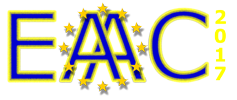Speaker
Mr
Paul Scherkl
(SUPA, University of Strathclyde, and the Cockcroft Institute)
Description
Advanced particle accelerators and their applications rely on exact synchronization and alignment of laser pulses with respect to charged particle beams. Prominent examples are pump-probe experiments with free electron lasers and plasma photocathode accelerators..
The presentation discusses a novel technique which harnesses enhanced plasma recombination glow from impact ionization from laser-triggered plasma sparks. Spatial as well as temporal transitions triggered by this interaction allow for synchronization and alignment of ultrashort electron beams and laser pulses with few or even sub-fs accuracy and µm-level spatial sensitivity. This system was developed as integral diagnostics for the E210 campaign at FACET via a simple and robust layout, which may find application in a wide range of conventional as well as plasma-based accelerator setups.
[1] A. Knetsch,T. Heinemann, P. Scherkl et al., to be submitted
Authors
Mr
Alexander Knetsch
(Deutsches Elektronen-Synchrotron DESY)
Mr
Paul Scherkl
(SUPA, University of Strathclyde, and the Cockcroft Institute)
Mr
Thomas Heinemann
(Uni Strathclyde / DESY)
Co-authors
Mr
Ahmad Fahim Habib
(Scottish Universities Physics Alliance, Department of Physics, University of Strathclyde, Glasgow, UK and Cockcroft Institute, Sci-Tech Daresbury, Keckwick Q2 Lane, Daresbury, Ceshire WA4 4AD, UK.)
Mr
Andrew Beaton
(University of Strathclyde)
Mr
Andrew Sutherland
(University of Strathclyde/SLAC)
Prof.
Bernhard Hidding
(University of Strathclyde / Hamburg)
Mr
Daniel Ullmann
(University of Strathclyde)
Dr
David Bruhwiler
(RadiaSoft LLC, Boulder, Colorado, USA)
Prof.
James Rosenzweig
(UCLA)
Mr
Oliver Karger
(University of Hamburg, Institute for Experimental Physics)
Mr
Panagiotis Delinikolas
(University of Strathclyde)

